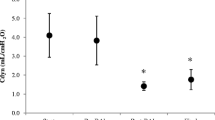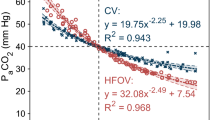Abstract
To examine the correlation DCO2/PaCO2 on high-frequency oscillatory ventilation (HFOV) combined with volume guarantee (VG) throughout increasing frequencies in two different respiratory conditions, physiological and low compliance. Neonatal animal model was used, before and after a bronchoalveolar lavage (BAL). HFOV combined with VG was used. The frequency was increased from 10 to 20 Hz, and high-frequency tidal volume (VThf) was gradually decreased maintaining a constant DCO2. Arterial partial pressure of carbon dioxide (PaCO2) was evaluated after each frequency and VThf change. Six 2-day-old piglets were studied. A linear decrease in PaCO2 was observed throughout increasing frequencies in both respiratory conditions while maintaining a constant DCO2, showing a significant difference between the initial PaCO2 (at 10 Hz) and the PaCO2 obtained at 18 and 20 Hz. A new DCO2 equation (corrected DCO2) was calculated in order to better define the correlation between DCO2 and the observed PaCO2.
Conclusion: The correlation DCO2/PaCO2 throughout increasing frequencies is not linear, showing a greater CO2 elimination efficiency at higher frequencies, in spite of maintaining a constant DCO2. So, using frequencies close to the resonant frequency of the respiratory system on HFOV combined with VG, optimizes the efficiency of gas exchange.
What is Known: • The efficacy of CO2removal during high-frequency oscillatory ventilation (HFOV), described as the diffusion coefficient of CO2(DCO2) is related to the square of the high-frequency tidal volume (VThf) and the frequency (f), expressed as DCO2= VThf2× f. | |
What is New: • The correlation between DCO2and PaCO2throughout increasing frequencies is not linear, showing a greater CO2elimination efficiency at higher frequencies. So, using very high frequencies on HFOV combined with volume guarantee optimizes the efficiency of gas exchange allowing to minimize lung injury. |





Similar content being viewed by others
Abbreviations
- BAL:
-
Bronchoalveolar lavage
- Cdyn:
-
Lung dynamic compliance
- CMV:
-
Conventional mechanical ventilation
- DCO2 :
-
Diffusion coefficient of CO2
- FiO2 :
-
Inspired oxygen fraction
- Hz:
-
Hertz
- HFOV:
-
High-frequency oscillatory ventilation
- mPaw:
-
Mean airway pressure
- PaCO2 :
-
Arterial partial pressure of carbon dioxide
- PaO2 :
-
Arterial partial pressure of oxygen
- PEEP:
-
Positive end-expiratory pressure
- RDS:
-
Respiratory distress syndrome
- SatO2 :
-
Arterial oxyhemoglobin saturation
- SD:
-
Standard deviation
- VG:
-
Volume guarantee
- VILI:
-
Ventilator-induced lung injury
- VThf:
-
High-frequency tidal volume
- ΔPhf:
-
Oscillation pressure amplitude
References
Belteki G, Lin B, Morley CJ (2017) Weight-correction of carbon dioxide diffusion coefficient (DCO2) reduces its inter-individual variability and improves its correlation with blood carbon dioxide levels in neonates receiving high-frequency oscillatory ventilation. Pediatr Pulmonol 52(10):1316–1322
Boynton BR, Hammond MD, Fredberg JJ, Buckley BG, Villanueva D, Frantz ID (1989) Gas exchange in healthy rabbits during high-frequency oscillatory ventilation. J Appl Physiol 66(3):1343–1351
Chan V, Greenough A, Milner AD (1993) The effect of frequency and mean airway pressure on volumen delivery during high-frequency oscillation. Pediatr Pulmonol 15(3):183–186
Dorkin HL, Stark AR, Werthammer JW, Strieder DJ, Fredberg JJ, Frantz ID 3rd (1983) Respiratory system impedance from 4 to 40 Hz in paralyzed intubated infants with respiratory disease. J Clin Invest 72(3):903–910
Froese AB, Kinsella JP (2005) High-frequency oscillatory ventilation: lessons from the neonatal/pediatric experience. Crit Care Med 33:S115–S121
González-Pacheco N, Sánchez-Luna M, Ramos-Navarro C, Navarro-Patiño N, de la Blanca AR (2016) Using very high frequencies with very low lung volumes during high frequency oscillatory ventilation to protect the immature lung. A pilot study. J Perinatol 36(4):306–310
González-Pacheco N, Sánchez-Luna M, Chimenti-Camacho P, Santos-González M, Palau-Concejo P, Tendillo-Cortijo F (2019) Use of very low tidal volumes during high-frequency ventilation reduces ventilator lung injury. J Perinatol 39(5):730–736
Harcourt ER, John J, Dargaville PA, Zannin E, Davis PG, Tingay DG (2014) Pressure and flow waveform characteristics of eight high-frequency oscillators. Pediatr Crit Care Med 15(5):e234–e240
Herrmann J, Tawhai MH, Kaczka DW (2016) Regional gas transport in the heterogeneous lung during oscillatory ventilation. J Appl Physiol 121(6):1306–1318
Iscan B, Duman N, Tuzun F, Kumral A, Ozkan H (2015) Impact of volume guarantee on high-frequency oscillatory ventilation in preterm infants: a randomized crossover clinical trial. Neonatology 108(4):277–282
Jaeger MJ, Kurzweg UH, Banner MJ (1984) Transport of gases in high-frequency ventilation. Crit Care Med 12(9):708–710
Lee S, Alexander J, Blowes R, Ingram D, Milner AD (1999) Determination of resonance frequency of the respiratory system in respiratory distress síndrome. Arch Dis Child Fetal Neonatal Ed 80(3):F198–F202
Mukerji A, Belik J, Sanchez-Luna M (2014) Bringing back the old: time to reevaluate the high-frequency ventilation strategy. J Perinatol 34:464–467
Pillow JJ (2005) High-frequency oscillatory ventilation: mechanisms of gas exchange and lung mechanics. Crit Care Med 33:S135–S141
Rossing TH, Slutsky AS, Lehr JL, Drinker PA, Kamm R, Drazen JM (1981) Tidal volume and frequency dependence of carbon dioxide elimination by high-frequency ventilation. N Engl J Med 305(23):1375–1379
Sánchez Luna M, Santos González M, Tendillo Cortijo F (2013) High-frequency oscillatory ventilation combined with volume guarantee in a neonatal animal model of respiratory distress syndrome. Crit Care Res Pract. https://doi.org/10.1155/2013/593915
Sánchez-Luna M, González-Pacheco N, Santos M, Blanco A, Orden C, Belik J, Tendillo FJ (2016) Effect of the I/E ratio on CO2 removal during high-frequency oscillatory ventilation with volumen guarantee in a neonatal animal model of RDS. Eur J Pediatr 175(10):1343–1351
Schindler M, Seear M (1991) The effect of lung mechanics on gas transport during high-frequency oscillation. Pediatr Pulmonol 11(4):335–339
Slutsky AS, Drazen FM, Ingram RH Jr, Kamm RD, Shapiro AH, Fredberg JJ, Lohring SH, Lehr J (1980) Effective pulmonary ventilation with small-volume oscillations at high frequency. Science 209(4456):609–611
Watson JW, Jackson AC, Gillespie JR (1984) CO2 elimination and airway opening pressure during high frequency oscillation in dogs. Respir Physiol 58(2):235–244
Zannin E, Dellaca RL, Dognini G, Marconi L, Perego M, Pillow JJ (2017) Effect of frequency on pressure cost of ventilation and gas exchange in newborns receiving high-frequency oscillatory ventilation. Pediatr Res 82(6):994–999
Acknowledgments
The authors thank Dräger Medical GmbH for providing the Babylog VN500 for the present study and Grupo de patología RESPIratoria y SURFactante de la SENeo (RESPIRUF) for funding the study.
Funding
This study was funded by “Grupo de patología RESPIratoria y SURFactante de la SENeo” (Ayuda a la Investigación Respisurf/Adolfo-Valls).
Author information
Authors and Affiliations
Contributions
Noelia González-Pacheco: design, development, data management, data interpretation and preparation of manuscript.
Manuel Sánchez-Luna: design, data interpretation, statistical analysis and preparation of manuscript.
Cristina Arribas-Sánchez: development and data management.
Martín Santos-González: design, development, data management and statistical analysis.
Cristina Orden-Quinto: development and data management.
Francisco Tendillo-Cortijo: design, development and data management.
Corresponding author
Ethics declarations
Conflict of interest
Manuel Sánchez-Luna declares receiving advisory board consulting fees from Dräger. The remaining authors declare that they have no competing interests.
Ethical approval
All applicable international, national, and institutional guidelines for the care and use of animals were followed (2010/63/UE and RD 53/2013). All procedures performed in studies involving animals were in accordance with the ethical standards of the institution or practice at which the studies were conducted (Ethics committee for animal research, Hospital Universitario Puerta de Hierro, Majadahonda, Madrid; CEEA: 004P/2017).
Additional information
Communicated by Patrick Van Reempts
Publisher’s note
Springer Nature remains neutral with regard to jurisdictional claims in published maps and institutional affiliations.
Rights and permissions
About this article
Cite this article
González-Pacheco, N., Sánchez-Luna, M., Arribas-Sánchez, C. et al. DCO2/PaCO2 correlation on high-frequency oscillatory ventilation combined with volume guarantee using increasing frequencies in an animal model. Eur J Pediatr 179, 499–506 (2020). https://doi.org/10.1007/s00431-019-03503-8
Received:
Revised:
Accepted:
Published:
Issue Date:
DOI: https://doi.org/10.1007/s00431-019-03503-8




